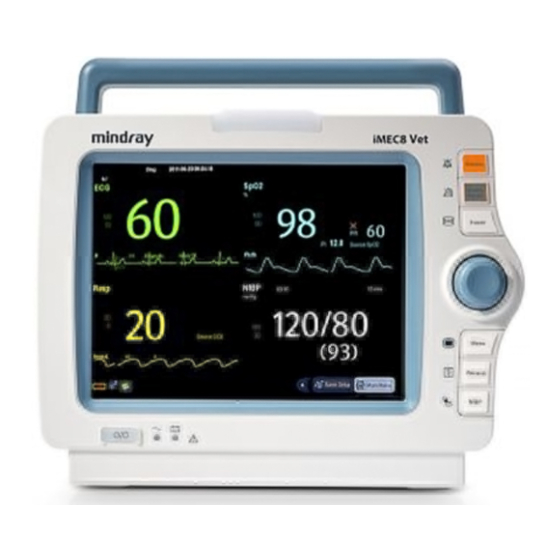
User Manuals: Mindray iMEC8 Vet Veterinary Monitor
Manuals and User Guides for Mindray iMEC8 Vet Veterinary Monitor. We have 1 Mindray iMEC8 Vet Veterinary Monitor manual available for free PDF download: Operator's Manual
Mindray iMEC8 Vet Operator's Manual (202 pages)
Portable Multi-Parameter Veterinary Monitor
Brand: Mindray
|
Category: Pet Care Product
|
Size: 2 MB
Table of Contents
-
1 Safety
17 -
2 The Basics
21-
-
Intended Use21
-
-
Front View21
-
Side View23
-
Rear View24
-
Quickkeys27
-
-
-
Installation29
-
Using Keys31
-
-
Night Mode37
-
Privacy Mode37
-
Demo Mode38
-
Standby Mode38
-
-
-
-
Introduction45
-
-
-
7 Alarms
55-
Alarm Levels56
-
-
Introduction67
-
Safety67
-
-
-
-
-
Introduction81
-
-
-
Introduction87
-
Safety88
-
-
-
-
Introduction95
-
Safety96
-
-
-
Introduction103
-
Safety103
-
Measuring PAWP109
-
-
-
Introduction111
-
Measuring CO112
-
Leakage Test116
-
-
17 Review
121 -
18 Calculations
125-
Introduction125
-
-
19 Recording
133-
Using a Recorder133
-
Loading Paper135
-
-
21 Batteries
141-
Overview141
-
-
-
General Points145
-
Cleaning145
-
Disinfecting146
-
-
23 Maintenance
147 -
24 Accessories
151-
ECG Accessories151
-
Spo152
-
NIBP Accessories153
-
Temp Accessories153
-
CO Accessories155
-
Others156
-
Data Storage160
-
Wireless Network161
-
-
-
Emc171
-
-
D Alarm Messages
187
Advertisement
